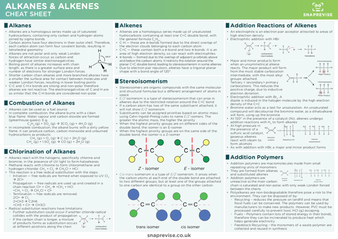A-Level Chemistry OCR Notes
4.1.3 Alkenes

Download Module Cheatsheet
Google rating
Trustpilot rating
Alkenes
- Alkenes are a homologous series made up of unsaturated hydrocarbons containing at least one C=C double bond, with the general formula CnH2n.
- C-H – these are σ-bonds formed due to the direct overlap of the electron clouds belonging to each carbon atom
- C=C – these contain both a σ-bond and two π-bonds. It is an area of high electron density, so can react with electrophiles.
- π-bonds – formed due to the overlap of adjacent p-orbitals above and below the carbon atoms. It restricts the rotation around the planar C=C double bond, leading to stereoisomerism in some alkenes
- Due to electron pair repulsion, alkenes have a trigonal planar shape with a bond angle of 120⁰.
Isomerism
- Isomers are compounds with the same molecular formula but a different arrangement of atoms
- Structural isomers are compounds with the same molecular formula but a different structural formula. They may contain the same functional group but on a different carbon atom, or different functional groups e.g. ketones and aldehydes with the same number of carbon atoms have the same molecular formula
Stereoisomerism
- Stereoisomers are organic compounds with the same molecular and structural formulae but a different arrangement of atoms in space
- E/Z isomerism is a type of stereoisomerism that can arise in alkenes due to the restricted rotation around the C=C bond
- If a carbon atom has two of the same substituent attached, it will not show E/Z isomerism
- Substituents can be assigned priorities based on atomic mass using Cahn-Ingold-Prelog rules to name E/Z isomers. The greater the atomic mass, the higher the priority
- When the highest priority groups are on different sides of the double bond, the isomer is an E-isomer.
- When the highest priority groups are on the same side of the double bond, the isomer is a Z-isomer
- Cis-trans isomerism is a type of E/Z isomerism. It arises when the carbon atoms at each end of the double bond are attached to two different groups, but at least one of the groups attached to one carbon are identical to a group on the other carbon
Addition Reactions of Alkenes
- An electrophile is an electron pair acceptor attracted to areas of high electron density
- Electrophilic addition with HBr
- Major and minor products form when an unsymmetrical alkene reacts. The major product will form from the most stable carbocation intermediate, with the most alkyl groups attached.
Tertiary > secondary > primary carbocations. This reduces the positive charge, due to inductive electron donation.
- Electrophilic addition with Br2. A dipole is induced in the halogen molecule by the high electron density of the C=C
- Bromine water acts as a test for unsaturation. An unsaturated compound will decolourise the bromine water, as a dihaloalkane will form, using up the bromine
- At 150° in the presence of a catalyst (Ni), alkenes undergo addition reactions with H2 to form alkanes
- At high pressure in the presence of a sulfuric acid catalyst, gaseous alkenes react with steam to form alcohols
- As with addition with HBr, a major and minor product forms
Addition Polymers
- Addition polymers are macromolecules made from small repeating units of monomers
- They are formed from alkenes and substituted alkenes
- Addition polymers are unreactive as the main carbon chain is saturated and non-polar, with only weak London forced between the chains
- Polyalkanes are non-biodegradable therefore pose a risk to the environment. They can be disposed of by:
- Recycling – reduces the pressure on landfill and means that fossil fuels can be conserved. The polymers can be used by manufacturers to make new products. However, PVC must be processed carefully to prevent toxic HCl (g) escaping
- Fuels – Polymers contain lots of stored energy in their bonds, therefore they can be incinerated to produce heat which helps generate electricity
- Feedstock Recycling – the monomers of a waste polymer are collected and reused in synthesis
Download as a full cheatsheet for free!

Download Now
Google rating
Trustpilot rating







